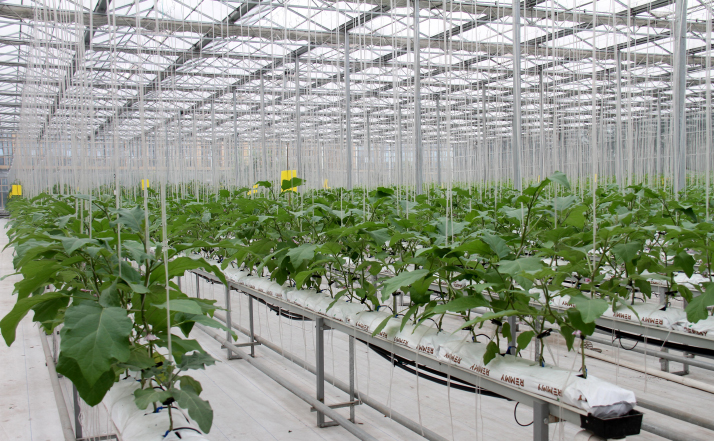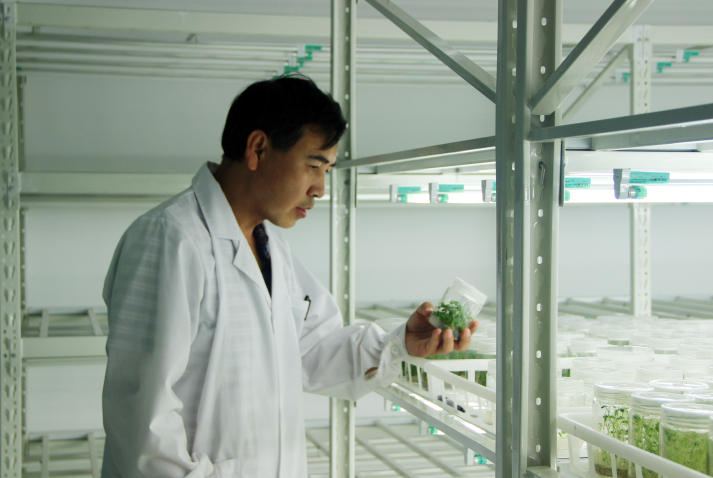| China |
| Hotbed of Innovation | |
| City in the dry north becomes cradle of hi-tech agricultural development | |
|
|
 Tomato seedlings cultivated in a vegetable greenhouse with fertigation technology in Jinzhong on January 2, 2019 (XINHUA)
Despite grass-withering outdoor temperature in January, vegetable seedlings in a greenhouse in the Shanxi Agricultural Valley are flourishing, filling the place with spring-like vitality. The plants are nourished with nutrients and water from a smart integrated drip irrigation and fertilizing equipment. The system can be operated via mobile phones or computers, said Zhang Xiuhua, Director of the General Office of the Shanxi Nonggu Biotechnology Research Institute. It is the fifth-generation such equipment developed by the institute. It collects data on temperature, humidity of soil and air, as well as light intensity through sensors placed in the greenhouse, and transmits them to a control platform so that operators can manage the greenhouse remotely. The institute is one of the many start-ups that have been founded in the Shanxi Agricultural Valley, named after the Silicon Valley. Located in Jinzhong in Shanxi Province in north China, the valley was launched in 2017 under a provincial strategy to boost innovation-driven agriculture. Recently, it has been upgraded into a national agricultural hi-tech industry demonstration zone (ATZ) to pioneer agricultural science and technology innovations and pilot agricultural supply-side reform. The first two national-level ATZs were approved for Jinzhong and Nanjing in Jiangsu Province, east China, in November 2019. Focusing on dry farming Lying on the Loess Plateau in central Shanxi, Jinzhong is a cradle of China's agrarian civilization. In the 1960s, a village there, Dazhai, was a national agricultural model. The 106-square-km ATZ will mainly feature organic dry farming technology and agricultural food processing, said Lan Yujie, Director of the Department of Science and Technology for Rural Development, Ministry of Science and Technology, at a press conference in Beijing in December 2019. The zone is planned to have an output value of 36 billion yuan ($5.2 billion) by 2023, with 70 percent of it coming from agricultural hi-tech industries. By that time, it will be home to 10 national-level research institutes and 40 hi-tech enterprises. Dry farming is usually practiced in arid areas without irrigation. Organic dry farming is important for the sustainable development of agriculture in north China. Seventy percent of the farmland in Shanxi is arid. The dry weather and limited water resources make it very difficult to expand irrigated land. So it is imperative to adopt dry farming techniques, Zhao Jianping, a top leader of Jinzhong, said at the press conference. The technique has benefited the Shanxi Tiansen Vegetable and Fruit Planting Base in the Agricultural Valley. Chang Jinli, a technical supervisor at the base, told the press that a smart fertigation system has reduced water consumption by one third and doubled the per unit yield in the base. Moreover, it saves labor. Only 30 employees are needed to manage 10.48 hectares. Stepping up innovation After the Central Government approved the establishment of the ATZ, a team was set up under Zhao to coordinate the work. To spur the development of advanced agricultural technology, the city is seeking collaboration with universities, research institutes and enterprises. Zhao visited the Shanxi Agricultural Valley and the Crop Ecology and Dry Cultivation Physiology Key Laboratory of Shanxi Agricultural University on January 3, suggesting they share resources. The government will support the commercialization of joint research outcomes, and the university will work with various departments in Jinzhong to establish national-level agricultural testing centers, he said. He also said the local government is seeking international cooperation to build the Agricultural Valley by introducing high-yield corn varieties from Mexico and advanced farming techniques from countries such as Spain, the United Kingdom and Ukraine. Agricultural equipment and facilities would be upgraded and agricultural standardization and automation enhanced. The city has released policies to attract outstanding researchers and entrepreneurs, offering research funding and perks such as housing subsidies. Agricultural biologist Shang Yongjin joined the Shanxi Juxin Weiye Agricultural Technology Development Co. Ltd., a flagship company in the valley, in 2017 and currently leads its research in detoxification, plant tissue culture, virus testing and genetic engineering breeding. The company is partnering with the academic community including China Agricultural University, the Institute of Vegetables and Flowers of the Chinese Academy of Agricultural Sciences, and Shanxi Agricultural University for scientific and technological innovation. It has developed more than 10 new strawberry varieties with independent intellectual property rights and more than 30 new vegetable varieties. In 2016, the company said it produced about 2 million virus-free strawberry seedlings, benefiting more than 210 households and creating more than 21 million yuan ($3 million) in economic benefits for farmers. It also generates income by opening up its strawberry fields to tourists. Since 2017, it has been cooperating with a strawberry research institute in Jilin Province in the northeast to develop strawberry seedlings. Now it has seedling bases in more than 10 provinces, producing more than 30 million virus-free strawberry seedlings annually, significantly improving farmers' output, Zhang Liming, manager of the company's vegetable project, said.  A researcher observes strawberry seedlings growing in a research center in Jinzhong, Shanxi Province in north China, on January 3, 2019 (XINHUA)
Smart development Advanced technology has also been adopted for animal husbandry. In January 2019, the Shanxi Nxin Technology Group Co. Ltd. won a bid to build a big data platform for hog production in Jinzhong. Last summer, two large pig farms signed contracts with the company to develop a smart farming system. These farms have implemented intelligent temperature and humidity regulation, ventilation, lighting and feeding, according to a local news portal. The report said the system has increased breeding efficiency with each sow able to give birth to more than 25 piglets per year, 40 percent higher than the average industry level. The farmers trade their products on e-commerce platform Z.Nxin.com. In recent years, science festivals and e-commerce training sessions have been organized in the area to help farmers market their products on the Internet. Zhao said a big data-powered comprehensive service platform has been set up in the Agricultural Valley to meet the demand of farmers across the province. The ATZ, he said, offers a great opportunity to accelerate innovation-driven development and improve the competitiveness of agriculture in Shanxi and even neighboring areas. Copyedited by Sudeshna Sarkar Comments to wanghairong@bjreview.com |
|
||||||||||||||||||||||||||||
|
